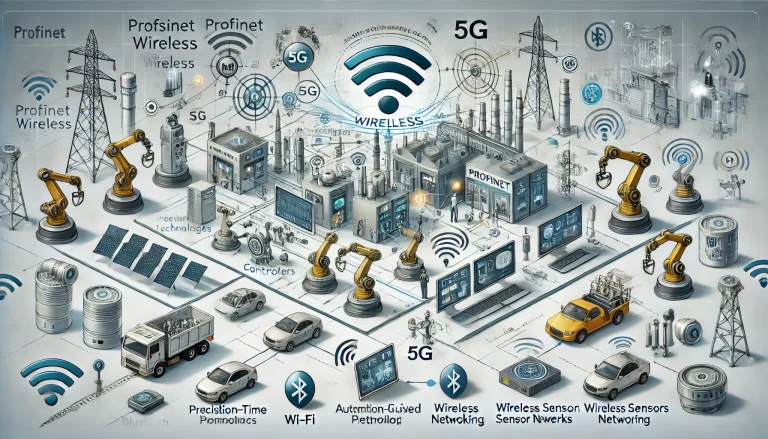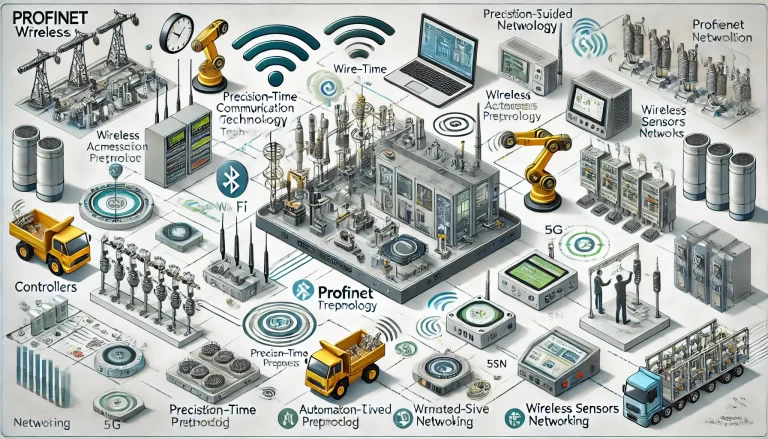Introduction
Profinet, a leading industrial Ethernet standard, has become an integral part of modern industrial automation. With the increasing demand for flexibility, mobility, and scalability in industrial environments, Profinet Wireless (Profinet over Wireless) has emerged as a crucial technology to address these needs. By leveraging wireless communication technologies such as Wi-Fi, 5G, and Bluetooth, Profinet Wireless ensures seamless and reliable data exchange in dynamic industrial settings.
This article explores the core technologies behind Profinet Wireless and its diverse applications across industries.
Core Technologies of Profinet Wireless
1. Network Architecture
Profinet Wireless architecture is an extension of the traditional Profinet framework, adapted to work in wireless environments. The core components include:
Controller: The main processing unit responsible for managing network operations and issuing control commands to devices.
Devices: Field-level devices such as sensors, actuators, and controllers that execute tasks based on received commands.
Access Points (APs): Facilitate wireless data transmission between controllers and devices.
Gateways: Bridge between wired and wireless networks, ensuring seamless connectivity and data integrity.
This hybrid structure ensures smooth integration of wireless components into existing Profinet-based automation systems.
2. Wireless Communication Technologies
Profinet Wireless supports several wireless communication technologies, including:
Wi-Fi (IEEE 802.11 standards): Provides high-speed data transfer suitable for manufacturing environments with moderate mobility requirements.
5G Networks: Offers ultra-low latency and high device density connectivity, making it ideal for complex industrial automation scenarios.
Bluetooth (BLE 5.0): Enables short-range, low-power communications for sensor networks and wearable devices.
RFID/NFC: Used for asset tracking and automated identification in logistics and manufacturing applications.
3. Real-Time Communication
Industrial environments require deterministic and real-time data exchange. Profinet Wireless achieves this through:
Precision Time Protocol (PTP): Ensures synchronized communication across all devices, minimizing latency.
Time-Sensitive Networking (TSN): Provides deterministic data delivery with minimal jitter and packet loss.
Redundancy Mechanisms: Utilizes Multiple Input Multiple Output (MIMO) and path redundancy to maintain robust connectivity.
4. Security Measures
Security is paramount in industrial wireless communications. Profinet Wireless incorporates various security protocols, such as:
Data Encryption: Advanced Encryption Standard (AES-256) and IPsec secure data during transmission.
Access Control: Protocols like 802.1X provide device authentication to prevent unauthorized access.
Threat Monitoring: Continuous monitoring and anomaly detection systems ensure network integrity.
5. Quality of Service (QoS) and Traffic Management
To prioritize critical industrial data, Profinet Wireless employs:
QoS Prioritization: Allocates bandwidth based on application importance.
Traffic Shaping: Smoothens data flow to avoid congestion.
Congestion Control: Implements algorithms to prevent data bottlenecks and optimize response times.

Applications of Profinet Wireless
1. Smart Manufacturing
Robotic Automation: Enables real-time control and monitoring of industrial robots.
Logistics and Warehousing: Automated Guided Vehicles (AGVs) and warehouse robots rely on wireless connectivity for navigation.
Remote Maintenance: Technicians can remotely diagnose and troubleshoot machinery issues.
2. Industrial Internet of Things (IIoT)
Wireless Sensor Networks (WSNs): Collects real-time production data to optimize operations.
Predictive Maintenance: IoT sensors monitor equipment health and predict failures.
Cloud Integration: Wireless-enabled devices send data to cloud platforms for analysis and decision-making.
3. Transportation and Infrastructure
Traffic Management: Wireless communication optimizes traffic signal control and vehicle coordination.
Infrastructure Monitoring: Remote monitoring of bridges, tunnels, and roads for structural integrity.
Railway and Airport Automation: Enables smart scheduling and control of operations.
4. Energy Sector
Oil and Gas Monitoring: Wireless sensors monitor pipeline conditions and facility operations.
Smart Grid Applications: Wireless data collection optimizes power distribution.
Renewable Energy Control: Solar and wind power systems benefit from wireless control networks.
5. Healthcare Automation
Smart Hospital Systems: Wireless connectivity supports equipment tracking and management.
Remote Diagnostics: Enables telemedicine applications in healthcare facilities.
Autonomous Medical Equipment: Supports automated medication dispensing and robotic surgeries.
Advantages and Challenges of Profinet Wireless
Advantages
Enhanced Flexibility: Wireless connectivity eliminates the need for physical cables, allowing greater adaptability in industrial environments.
Scalability: Easily expands to accommodate additional devices without significant infrastructure changes.
Cost Reduction: Reduces installation and maintenance costs associated with wired networks.
Remote Accessibility: Enables real-time monitoring and control from remote locations.
Improved Productivity: Enhances operational efficiency with real-time data availability.
Challenges
Signal Interference: Industrial environments pose challenges due to electromagnetic interference from machinery.
Latency Concerns: Wireless networks may introduce latency, impacting time-critical operations.
Security Risks: Wireless networks are susceptible to cyberattacks and data breaches.
Compatibility Issues: Integrating with legacy wired systems can pose challenges.

Future Trends of Profinet Wireless
Integration with 5G Technology: The rollout of industrial 5G will significantly enhance Profinet Wireless capabilities with ultra-low latency and high reliability.
Edge Computing Integration: Reducing cloud dependency and processing data closer to the source.
AI-driven Automation: Leveraging AI to optimize network performance and predictive analytics.
Interoperability Enhancements: Improved compatibility with other industrial communication protocols.
Energy-Efficient Wireless Solutions: Adoption of low-power wireless technologies for IoT devices.
Conclusion
Profinet Wireless is revolutionizing industrial automation by providing greater flexibility, scalability, and efficiency. Despite challenges such as signal interference and security risks, its advantages far outweigh the limitations, making it a crucial technology for smart factories and IIoT applications.
As wireless communication technologies continue to evolve, Profinet Wireless will play an increasingly vital role in driving Industry 4.0 initiatives and enabling intelligent, connected production environments.
